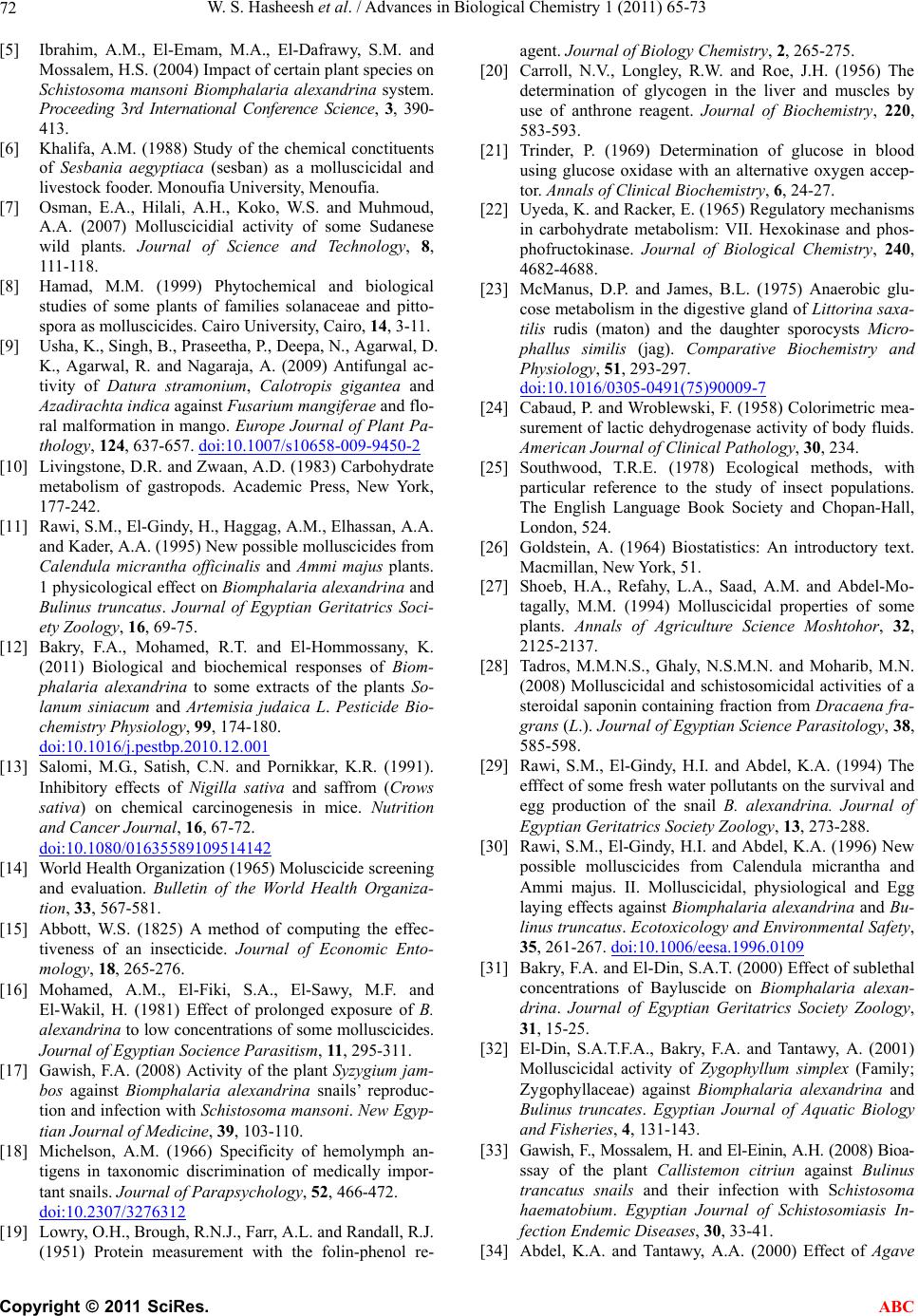
W. S. Hasheesh et al. / Advances in Biological Chemistry 1 (2011) 65-73
72
[5] Ibrahim, A.M., El-Emam, M.A., El-Dafrawy, S.M. and
Mossalem, H.S. (2004) Impact of certain plant species on
Schistosoma mansoni Biomphalaria alexandrina system.
Pr oceeding 3rd International Conference Science, 3, 390-
413.
[6] Khalifa, A.M. (1988) Study of the chemical conctituents
of Sesbania aegyptiaca (sesban) as a molluscicidal and
livestock fooder. Monoufia University, Menoufia.
[7] Osman, E.A., Hilali, A.H., Koko, W.S. and Muhmoud,
A.A. (2007) Molluscicidial activity of some Sudanese
wild plants. Journal of Science and Technology, 8,
111-118.
[8] Hamad, M.M. (1999) Phytochemical and biological
studies of some plants of families solanaceae and pitto-
spora as molluscicides. Cairo University, Cairo, 14, 3-11.
[9] Usha, K., Singh, B., Prase etha , P., Deepa, N., Agarwal, D.
K., Agarwal, R. and Nagaraja, A. (2009) Antifungal ac-
tivity of Datura stramonium, Calotropis gigantea and
Azadirachta indica against Fusarium mangiferae and flo-
ral malformation in mango. Europe Journal of Plant Pa-
thology, 124, 637-657. doi:10.1007/s10658-009-9450-2
[10] Livingstone, D.R. and Zwaan, A.D. (1983) Carbohydrate
metabolism of gastropods. Academic Press, New York,
177-242.
[11] Rawi, S.M., El-Gindy, H., Haggag, A.M., Elhassan, A.A.
and Kader, A.A. (1995) New possible molluscicides from
Calendula micrantha officinalis and Ammi majus plants.
1 physicological effect on Biomphalaria alexandrina and
Bulinus truncatus. Journal of Egyptian Geritatrics Soci-
ety Zoology, 16, 69-75.
[12] Bakry, F.A., Mohamed, R.T. and El-Hommossany, K.
(2011) Biological and biochemical responses of Biom-
phalaria alexandrina to some extracts of the plants So-
lanum siniacum and Artemisia judaica L. Pesticide Bio-
chemistry Physiology , 99, 174-180.
doi:10.1016/j.pestbp.2010.12.001
[13] Salomi, M.G., Satish, C.N. and Pornikkar, K.R. (1991).
Inhibitory effects of Nigilla sativa and saffrom (Crows
sativa) on chemical carcinogenesis in mice. Nutrition
and Cancer Journal, 16, 67-72.
doi:10.1080/01635589109514142
[14] World Health Organization (1965) Moluscicide screening
and evaluation. Bulletin of the World Health Organiza-
tion, 33, 567-581.
[15] Abbott, W.S. (1825) A method of computing the effec-
tiveness of an insecticide. Journal of Economic Ento-
mology, 18, 265-276.
[16] Mohamed, A.M., El-Fiki, S.A., El-Sawy, M.F. and
El-Wakil, H. (1981) Effect of prolonged exposure of B.
alexandrina to low concentrations of some molluscicides.
Journal of Egyptian Socie nce Parasitism, 11 , 295-311.
[17] Gawish, F.A. (2008) Activity of the plant Syzygium jam-
bos against Biomphalaria alexandrina snails’ reproduc-
tion and infection with Schistosoma mansoni. New Egyp-
tian Journal of Medicine, 39, 103-110.
[18] Michelson, A.M. (1966) Specificity of hemolymph an-
tigens in taxonomic discrimination of medically impor-
tant snails. Journal of Parapsychology, 52, 466-472.
doi:10.2307/3276312
[19] Lowry, O.H., Brough, R.N.J., Farr, A.L. and Randall, R.J.
(1951) Protein measurement with the folin-phenol re-
agent. Journal of Biology Chemistry, 2, 265-275.
[20] Carroll, N.V., Longley, R.W. and Roe, J.H. (1956) The
determination of glycogen in the liver and muscles by
use of anthrone reagent. Journal of Biochemistry, 220,
583-593.
[21] Trinder, P. (1969) Determination of glucose in blood
using glucose oxidase with an alternative oxygen accep-
tor. Annals of Clinical Biochemistry, 6, 24-27.
[22] Uyeda, K. and Racker, E. (1965) Regulatory mechanisms
in carbohydrate metabolism: VII. Hexokinase and phos-
phofructokinase. Journal of Biological Chemistry, 240,
4682-4688.
[23] McManus, D.P. and James, B.L. (1975) Anaerobic glu-
cose metabolism in the digestive gland of Littorina saxa-
tilis rudis (maton) and the daughter sporocysts Micro-
phallus similis (jag). Comparative Biochemistry and
Physiology, 51, 293-297.
doi:10.1016/0305-0491(75)90009-7
[24] Cabaud, P. and Wroblewski, F. (1958) Colorimetric mea-
surement of lactic dehydrogenase activity of body fluids.
American Journal of Clinical Pathology, 30, 234.
[25] Southwood, T.R.E. (1978) Ecological methods, with
particular reference to the study of insect populations.
The English Language Book Society and Chopan-Hall,
London, 524.
[26] Goldstein, A. (1964) Biostatistics: An introductory text.
Macmillan, New York, 51.
[27] Shoeb, H.A., Refahy, L.A., Saad, A.M. and Abdel-Mo-
tagally, M.M. (1994) Molluscicidal properties of some
plants. Annals of Agriculture Science Moshtohor, 32,
2125-2137.
[28] Tadros, M.M.N.S., Ghaly, N.S.M.N. and Moharib, M.N.
(2008) Molluscicidal and schistosomicidal activities of a
steroidal saponin containing fraction from Dracaena fra-
grans (L.). Journal of Egyptian Science Parasitology, 38,
585-598.
[29] Rawi, S.M., El-Gindy, H.I. and Abdel, K.A. (1994) The
efffect of some fresh water pollutants on the survival and
egg production of the snail B. alexandrina. Journal of
Egyptian Geritatrics Society Zoology, 13, 273-288.
[30] Rawi, S.M., El-Gindy, H.I. and Abdel, K.A. (1996) New
possible molluscicides from Calendula micrantha and
Ammi majus. II. Molluscicidal, physiological and Egg
laying effects against Biomphalaria alexandrina and Bu-
linus truncatus. Ecotoxicology and Environmental Safety,
35, 261-267. doi:10.1006/eesa.1996.0109
[31] Bakry, F.A. and El-Din, S.A.T. (2000) Effect of sublethal
concentrations of Bayluscide on Biomphalaria alexan-
drina. Journal of Egyptian Geritatrics Society Zoology,
31, 15-25.
[32] El-Din, S.A.T.F.A., Bakry, F.A. and Tantawy, A. (2001)
Molluscicidal activity of Zygophyllum simplex (Family;
Zygophyllaceae) against Biomphalaria alexandrina and
Bulinus truncates. Egyptian Journal of Aquatic Biology
and Fisheries, 4, 131-143.
[33] Gawish, F., Mossalem, H. and El-Einin, A. H. (2008) Bioa-
ssay of the plant Callistemon citriun against Bulinus
trancatus snails and their infection with Schistosoma
haematobium. Egyptian Journal of Schistosomiasis In-
fection Endemic Diseases, 30, 33-41.
[34] Abdel, K.A. and Tantawy, A.A. (2000) Effect of Agave
C
opyright © 2011 SciRes. ABC